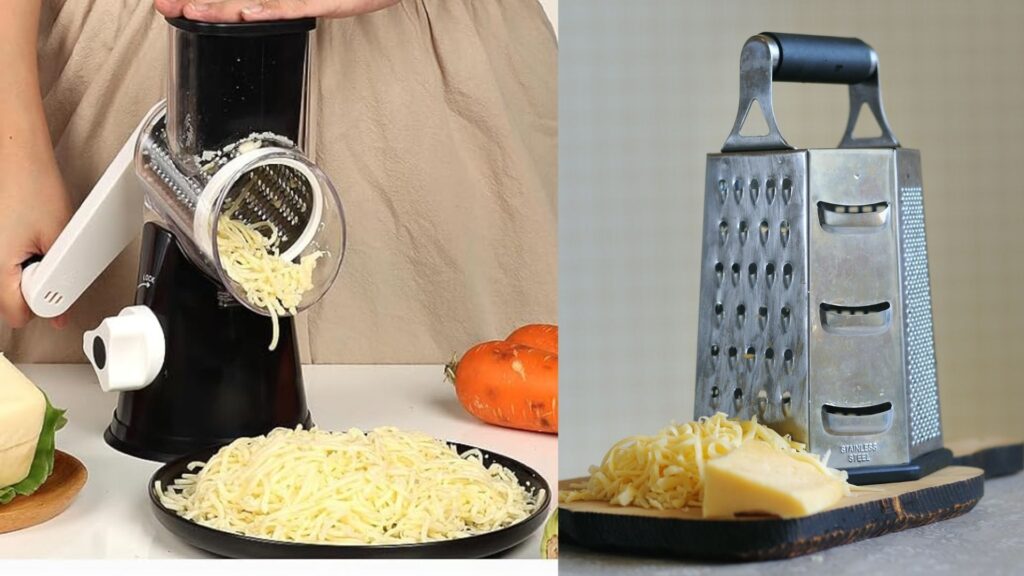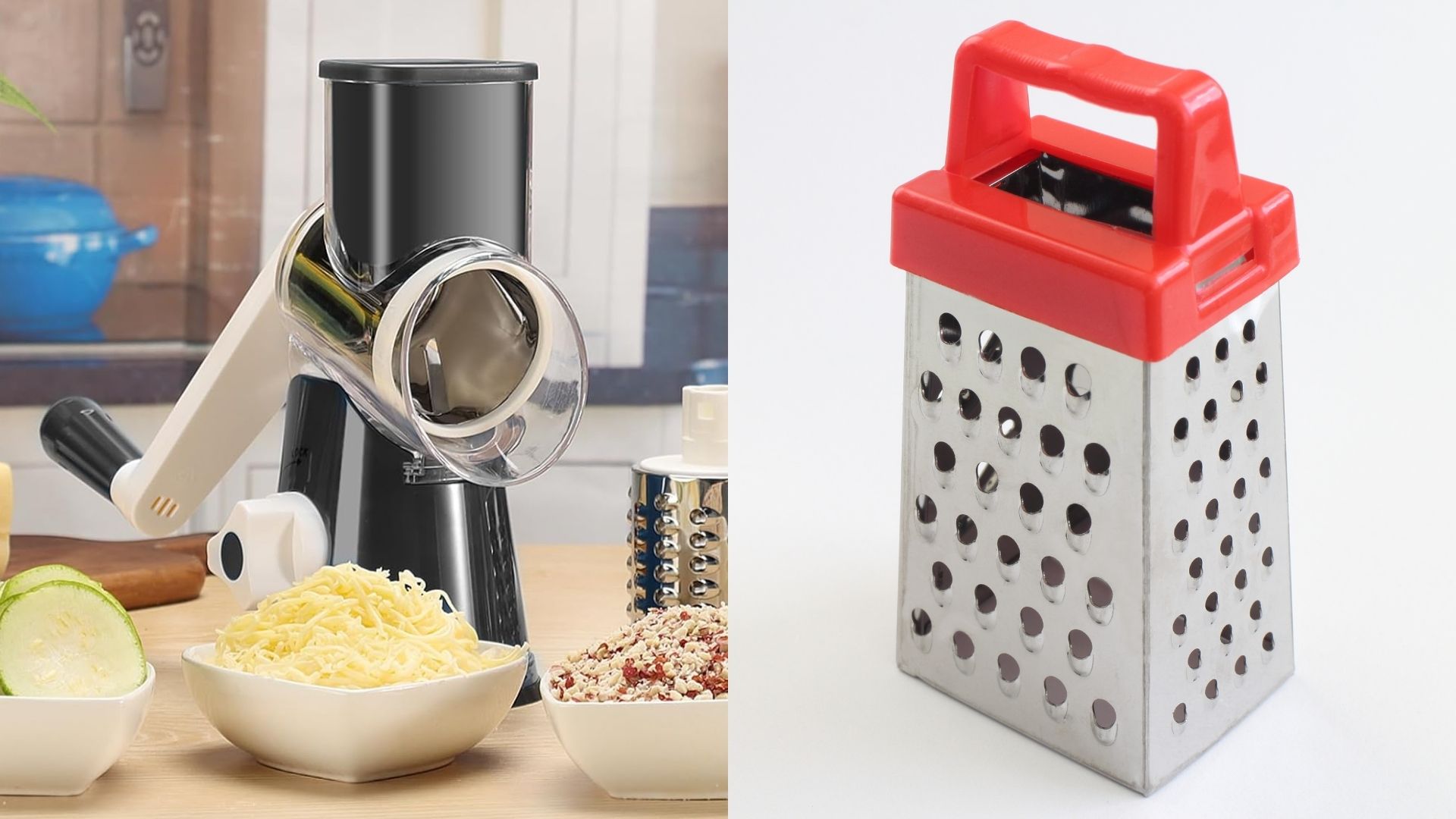Grating is a fundamental task in the kitchen, essential for preparing a variety of dishes. The choice of grater can significantly impact the efficiency and safety of this process. Traditional box graters have been a staple in kitchens for decades, offering multiple grating surfaces for different textures. However, modern innovations like the Cambom Rotary Cheese Grater have introduced new features aimed at enhancing user experience.
This article explores the differences between the Cambom Rotary Cheese Grater and traditional graters, examining aspects such as design, functionality, safety, and versatility to help you make an informed choice for your culinary needs.
Why Compare Graters?
Understanding the distinctions between various types of graters is crucial for several reasons:
- Efficiency: The right grater can streamline food preparation, saving time and effort.
- Safety: Different designs offer varying levels of safety, reducing the risk of injury.
- Versatility: Some graters are more adaptable, capable of handling a wider range of foods and textures.
- Maintenance: Ease of cleaning and durability are important factors in the longevity of kitchen tools.
Cambom Grater vs. Traditional Graters: In Depth Comparison

Design and Functionality
Traditional Box Graters
Traditional box graters are typically four-sided, each side featuring different grating surfaces:
- Coarse Grater: Ideal for shredding cheese and vegetables.
- Fine Grater: Suitable for zesting citrus fruits and grating hard cheeses.
- Slicer: Used for slicing vegetables like cucumbers and carrots.
- Shredder: For shredding foods into fine pieces.
These graters are straightforward and require manual effort, with the user pressing the food against the grating surface.
Cambom Rotary Cheese Grater
The Cambom Rotary Cheese Grater features a cylindrical drum with interchangeable blades and a hand-crank mechanism:
- Interchangeable Blades: Includes coarse shredding, fine shredding, and slicing blades.
- Hand-Crank Operation: Allows for continuous grating by turning the handle, reducing manual pressure.
- Suction Base: Provides stability by securing the grater to the countertop.
This design aims to make grating more efficient and less physically demanding.
Safety Considerations
Traditional Box Graters
Using a box grater involves pressing food against sharp surfaces, which can lead to:
- Risk of Injury: Fingers are in close proximity to the blades, increasing the chance of cuts.
- Physical Strain: Requires significant manual effort, which can be tiring.
Cambom Rotary Cheese Grater
The rotary design offers enhanced safety features:
- Hand-Crank Mechanism: Keeps hands away from the blades during operation.
- Food Pusher: Guides food into the grater, minimizing direct contact.
- Stable Base: The suction base prevents slipping, reducing the risk of accidents.
These features collectively reduce the likelihood of injury and make the grating process more comfortable.
Versatility and Applications
Traditional Box Graters
Box graters are versatile and can handle a variety of tasks:
- Cheese: Grating soft and hard cheeses.
- Vegetables: Shredding carrots, potatoes, and zucchini.
- Zesting: Finely grating citrus peels.
However, they may not be as efficient with larger quantities or harder foods.
Cambom Rotary Cheese Grater
The Cambom grater is designed for versatility:
- Cheese: Efficiently grates both soft and hard cheeses.
- Vegetables: Slices and shreds vegetables like cucumbers, carrots, and radishes.
- Nuts: Capable of grinding nuts for baking or toppings.
Its interchangeable blades and hand-crank operation make it suitable for a wide range of foods and textures.
Maintenance and Durability
Traditional Box Graters
- Cleaning: Can be challenging due to food particles getting stuck in the grating surfaces.
- Durability: Generally durable but can dull over time with heavy use.
Cambom Rotary Cheese Grater
- Cleaning: Designed for easy disassembly, making it simpler to clean thoroughly.
- Durability: Constructed with food-grade materials and stainless steel blades, offering resistance to rust and wear.
Proper maintenance of both types is essential to ensure longevity and optimal performance.
User Experience
Traditional Box Graters
- Effort: Requires significant manual effort, which can be tiring, especially for large quantities.
- Control: Offers direct control over the grating process but at the cost of increased physical strain.
Cambom Rotary Cheese Grater
- Effort: The hand-crank mechanism reduces physical exertion, making it easier to grate larger quantities.
- Control: Provides consistent results with less manual input, enhancing the overall user experience.
Cost Considerations
Traditional Box Graters
- Price Range: Generally affordable, with prices varying based on brand and material quality.
Cambom Rotary Cheese Grater
- Price Range: Slightly higher due to additional features and components but offers added value through enhanced functionality and safety.
Frequently Asked Questions
Can the Cambom Rotary Cheese Grater handle hard cheeses like Parmesan?
Yes, the Cambom Rotary Cheese Grater is designed to efficiently grate both soft and hard cheeses, including Parmesan.
Is the Cambom grater dishwasher safe?
Yes, the Cambom Rotary Cheese Grater is dishwasher safe, making cleanup convenient and easy.
How does the suction base work on different surfaces?
The suction base is designed to adhere securely to smooth, non-porous surfaces such as granite, glass, or polished countertops. For optimal performance, ensure the surface is clean and dry before attaching the grater.
What materials are used in the construction of the Cambom grater?
The Cambom Rotary Cheese Grater is constructed with food-grade BPA-free plastic for the body and high-quality stainless steel for the blades, ensuring durability and safety.
Can the Cambom grater be used for foods other than cheese?
Yes, the Cambom grater is versatile and can be used to grate or slice various foods, including vegetables like carrots and cucumbers, nuts, and even chocolate.
Comparison Table: Cambom Rotary Cheese Grater vs. Traditional Box Grater
| Feature | Cambom Rotary Cheese Grater | Traditional Box Grater |
|---|---|---|
| Design | Hand-crank mechanism with interchangeable blades and suction base for stability. | Four-sided grater with different grating surfaces; requires manual pressure. |
| Safety | Hands are kept away from blades during operation, reducing risk of injury. | Hands are in close proximity to blades, increasing the risk of cuts. |
| Efficiency | Hand-crank allows for continuous grating with less physical effort. | Requires significant manual effort, especially for larger quantities. |
| Versatility | Suitable for grating and slicing a variety of foods, including cheeses, vegetables, and nuts. | Versatile but may not handle all food types as efficiently. |
| Cleaning | Easily disassembled for thorough cleaning; dishwasher safe. | Can be challenging to clean, especially if food gets stuck in the grating surfaces. |
| Storage | Compact design with detachable parts for easy storage. | Bulkier design may require more storage space. |
| Durability | Constructed with durable materials; blades are resistant to rust. | Durable but blades may dull over time with heavy use. |
| Price | Moderately priced, offering good value for the features provided. | Generally more affordable, with prices varying based on brand and material quality. |
Conclusion
When choosing between the Cambom Rotary Cheese Grater and a traditional box grater, consider factors such as safety, efficiency, versatility, and ease of maintenance. The Cambom grater offers enhanced safety features, reduced physical effort, and greater versatility, making it a valuable addition to modern kitchens.
However, traditional box graters remain a reliable and cost-effective option for those who prefer a straightforward tool. Assess your specific needs and preferences to select the grater that best suits your culinary tasks.



